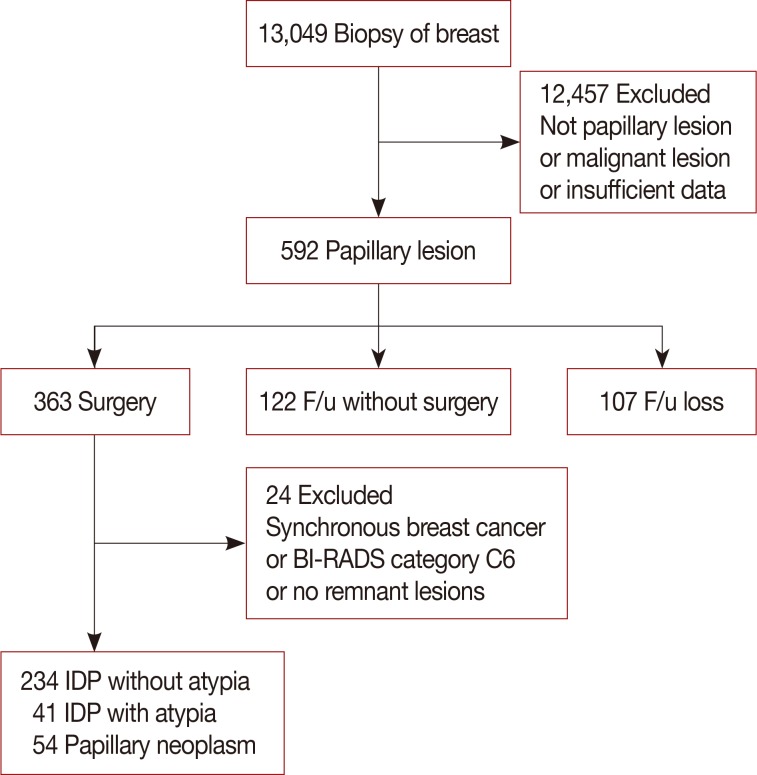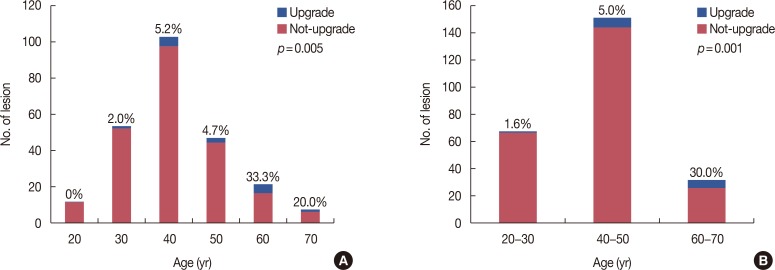J Breast Cancer.
2016 Dec;19(4):410-416. 10.4048/jbc.2016.19.4.410.
Predictive Factors for Upgrading Patients with Benign Breast Papillary Lesions Using a Core Needle Biopsy
- Affiliations
-
- 1Department of Surgery, CHA Bundang Medical Center, CHA University, Seongnam, Korea.
- 2Department of Surgery, The Catholic University of Korea College of Medicine, Seoul, Korea. bjchae@gmail.com
- 3Department of Radiology, The Catholic University of Korea College of Medicine, Seoul, Korea.
- 4Cancer Research Institute, The Catholic University of Korea College of Medicine, Seoul, Korea.
- KMID: 2362927
- DOI: http://doi.org/10.4048/jbc.2016.19.4.410
Abstract
- PURPOSE
Intraductal papilloma (IDP) is a benign breast disease with malignant potential, for which complete surgical excision is usually recommended. The aim of the present study was to investigate predictive factors for upgrading patients with a benign papillary lesion (BPL).
METHODS
This study was an observational study using a prospectively collected cohort. In total, 13,049 patients who underwent a core needle biopsy (CNB) for a breast lesion between January 2009 and May 2015 were enrolled. We reviewed all patients with pathologically confirmed BPL from a CNB.
RESULTS
Surgical treatment was performed for 363 out of a total of 592 lesions. According to the pathological differences, the lowest upgrade rate was shown in IDP without atypia (without atypia, 6.0%; with atypia, 26.8%; papillary neoplasm, 31.5%; p<0.001). The univariate analysis showed that, in IDP without atypia, the age at diagnosis, size of BPL on ultrasonography, and density on mammography were associated with upgrading. The multivariate analysis revealed that age >54 years and lesion size >1 cm were significantly associated with upgrade to malignancy (odds ratio [OR]=4.351, p=0.005 and OR=4.236, p=0.001, respectively).
CONCLUSION
The indications for surgical treatment can be defined as age >54 years and mass size >1 cm, even in IDP without atypia in the CNB results; this also includes cases of IDP with atypia or papillary neoplasm. Therefore, we suggest that close observation without surgery is sufficient for younger women with a small IDP without atypia.
MeSH Terms
Figure
Cited by 1 articles
-
Benign Intraductal Papilloma without Atypia on Core Needle Biopsy Has a Low Rate of Upgrading to Malignancy after Excision
Song-Hee Han, Milim Kim, Yul Ri Chung, Bo La Yun, Mijung Jang, Sun Mi Kim, Eunyoung Kang, Eun-Kyu Kim, So Yeon Park
J Breast Cancer. 2018;21(1):80-86. doi: 10.4048/jbc.2018.21.1.80.
Reference
-
1. Shamonki J, Chung A, Huynh KT, Sim MS, Kinnaird M, Giuliano A. Management of papillary lesions of the breast: can larger core needle biopsy samples identify patients who may avoid surgical excision? Ann Surg Oncol. 2013; 20:4137–4144. PMID: 23943035.
Article2. Nayak A, Carkaci S, Gilcrease MZ, Liu P, Middleton LP, Bassett RL Jr, et al. Benign papillomas without atypia diagnosed on core needle biopsy: experience from a single institution and proposed criteria for excision. Clin Breast Cancer. 2013; 13:439–449. PMID: 24119786.
Article3. Rizzo M, Linebarger J, Lowe MC, Pan L, Gabram SG, Vasquez L, et al. Management of papillary breast lesions diagnosed on core-needle biopsy: clinical pathologic and radiologic analysis of 276 cases with surgical follow-up. J Am Coll Surg. 2012; 214:280–287. PMID: 22244207.
Article4. Mercado CL, Hamele-Bena D, Oken SM, Singer CI, Cangiarella J. Papillary lesions of the breast at percutaneous core-needle biopsy. Radiology. 2006; 238:801–808. PMID: 16424237.
Article5. Skandarajah AR, Field L, Yuen Larn Mou A, Buchanan M, Evans J, Hart S, et al. Benign papilloma on core biopsy requires surgical excision. Ann Surg Oncol. 2008; 15:2272–2277. PMID: 18473143.
Article6. Ahmadiyeh N, Stoleru MA, Raza S, Lester SC, Golshan M. Management of intraductal papillomas of the breast: an analysis of 129 cases and their outcome. Ann Surg Oncol. 2009; 16:2264–2269. PMID: 19484312.
Article7. Nakhlis F, Ahmadiyeh N, Lester S, Raza S, Lotfi P, Golshan M. Papilloma on core biopsy: excision vs. observation. Ann Surg Oncol. 2015; 22:1479–1482. PMID: 25361885.
Article8. Renshaw AA, Derhagopian RP, Tizol-Blanco DM, Gould EW. Papillomas and atypical papillomas in breast core needle biopsy specimens: risk of carcinoma in subsequent excision. Am J Clin Pathol. 2004; 122:217–221. PMID: 15323138.9. Jaffer S, Nagi C, Bleiweiss IJ. Excision is indicated for intraductal papilloma of the breast diagnosed on core needle biopsy. Cancer. 2009; 115:2837–2843. PMID: 19402174.
Article10. Yang Y, Suzuki K, Abe E, Li C, Uno M, Akiyama F, et al. The significance of combined CK5/6 and p63 immunohistochemistry in predicting the risks of subsequent carcinoma development in intraductal papilloma of the breast. Pathol Int. 2015; 65:81–88. PMID: 25572436.
Article11. Rakha EA. Morphogenesis of the papillary lesions of the breast: phenotypic observation. J Clin Pathol. 2016; 69:64–69. PMID: 26251523.
Article12. Hoshikawa S, Sano T, Hirato J, Oyama T, Fukuda T. Immunocytochemical analysis of p63 and 34betaE12 in fine needle aspiration cytology specimens for breast lesions: a potentially useful discriminatory marker between intraductal papilloma and ductal carcinoma in situ. Cytopathology. 2016; 27:108–114. PMID: 25810244.13. Pathmanathan N, Albertini AF, Provan PJ, Milliken JS, Salisbury EL, Bilous AM, et al. Diagnostic evaluation of papillary lesions of the breast on core biopsy. Mod Pathol. 2010; 23:1021–1028. PMID: 20473278.
Article14. Jagmohan P, Pool FJ, Putti TC, Wong J. Papillary lesions of the breast: imaging findings and diagnostic challenges. Diagn Interv Radiol. 2013; 19:471–478. PMID: 23996839.
Article15. Carder PJ, Garvican J, Haigh I, Liston JC. Needle core biopsy can reliably distinguish between benign and malignant papillary lesions of the breast. Histopathology. 2005; 46:320–327. PMID: 15720418.
Article16. Puglisi F, Zuiani C, Bazzocchi M, Valent F, Aprile G, Pertoldi B, et al. Role of mammography, ultrasound and large core biopsy in the diagnostic evaluation of papillary breast lesions. Oncology. 2003; 65:311–315. PMID: 14707450.
Article17. Patel BK, Falcon S, Drukteinis J. Management of nipple discharge and the associated imaging findings. Am J Med. 2015; 128:353–360. PMID: 25447625.
Article18. Cheng TY, Chen CM, Lee MY, Lin KJ, Hung CF, Yang PS, et al. Risk factors associated with conversion from nonmalignant to malignant diagnosis after surgical excision of breast papillary lesions. Ann Surg Oncol. 2009; 16:3375–3379. PMID: 19641969.
Article19. Shiino S, Tsuda H, Yoshida M, Jimbo K, Asaga S, Hojo T, et al. Intraductal papillomas on core biopsy can be upgraded to malignancy on subsequent excisional biopsy regardless of the presence of atypical features. Pathol Int. 2015; 65:293–300. PMID: 25801805.
Article20. Jacobs TW, Connolly JL, Schnitt SJ. Nonmalignant lesions in breast core needle biopsies: to excise or not to excise? Am J Surg Pathol. 2002; 26:1095–1110. PMID: 12218567.21. Loh SF, Cooper C, Selinger CI, Barnes EH, Chan C, Carmalt H, et al. Cell cycle marker expression in benign and malignant intraductal papillary lesions of the breast. J Clin Pathol. 2015; 68:187–191. PMID: 25501285.
Article22. Lin CH, Liu CH, Wen CH, Ko PL, Chai CY. Differential CD133 expression distinguishes malignant from benign papillary lesions of the breast. Virchows Arch. 2015; 466:177–184. PMID: 25433813.
Article23. Weisman PS, Sutton BJ, Siziopikou KP, Hansen N, Khan SA, Neuschler EI, et al. Non-mass-associated intraductal papillomas: is excision necessary? Hum Pathol. 2014; 45:583–588. PMID: 24444467.
Article24. Mosier AD, Keylock J, Smith DV. Benign papillomas diagnosed on large-gauge vacuum-assisted core needle biopsy which span <1.5 cm do not need surgical excision. Breast J. 2013; 19:611–617. PMID: 24102818.
- Full Text Links
- Actions
-
Cited
- CITED
-
- Close
- Share
- Similar articles
-
- Clinicopathologic Features of the Papillary Breast Lesions Diagnosed on Ultrasonography-guided Core Needle Biopsy
- A Study Regarding Predictive Factors for Malignancy of Papillary Lesions on Core Needle Biopsy of the Breast
- Benign Intraductal Papilloma without Atypia on Core Needle Biopsy Has a Low Rate of Upgrading to Malignancy after Excision
- Sonographically-Guided 14-Gauge Core Needle Biopsy for Papillary Lesions of the Breast
- Breast Lesions with Discordant Results on Ultrasound-guided Core Needle Biopsy



